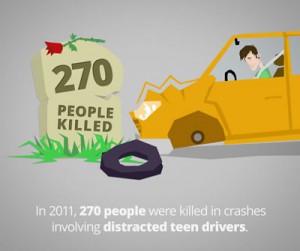National Teen Driver Safety Week: October 19-25
 The National Highway Traffic Safety Administration urges teenage drivers to keep safety in mind during National Teen Driver Safety Week 2014.
The National Highway Traffic Safety Administration urges teenage drivers to keep safety in mind during National Teen Driver Safety Week 2014.
Car accidents remain the leading cause of death for 14-18 year olds in the U.S. In the year 2011 alone, car accidents sent 292,000 teenagers to the hospital, according to the Centers for Disease Control and Prevention. More than 2,500 drivers between the ages of 16 and 19 were killed in motor vehicle crashes in 2011, adding up to seven teen deaths every single day. Drivers between the ages 16 and 19 are nearly three times more likely than drivers 20 or older to be killed in a car crash.
Despite the widespread problem of teen car accidents, approximately 75 percent of parents of teenagers have not had a serious talk with their children about vehicle safety.
According to the NHTSA, the five most serious problems facing teenage drivers are:
- Alcohol: Despite being too young to legally purchase or consume alcohol, teenage drivers are at the greatest risk of death in alcohol-related crashes. In the year 2012, of all 15-20 year-old drivers killed in motor vehicle crashes, 28 percent had some amount of alcohol in their system.
- Seat belts: More than half of all 15-20 year-olds killed in car accidents in 2012 were not wearing seat belts.
- Texting: Of all drivers ages 15-20 who were reportedly distracted during fatal car accidents, approximately 1 in 5 were distracted by phones. Teenage drivers are more likely than any other age group to be distracted by their phones while driving. While texting, a driver’s eyes are off the road for an average of 5 seconds; at a speed of 55 miles per hour, 5 seconds is long enough to cover the length of a football field blindfolded. The University of Michigan Transportation Research Institute found that a quarter of teens respond to at least one text message every time they drive; 20 percent of teens admit to having extended, multi-message conversations while driving.
- Speeding: Excessive speed contributed to 48 percent of all fatal crashes involving 15-20 year-old drivers.
- Passengers: The Allstate Foundation found that half of all teen drivers admit they are safer drivers without their friends in the car. Many states have laws in place to limit the number of passengers in the car with a teenage driver to minimize the risk of a tragic accident. Especially during the first months of licensure, when crash risk is particularly high, having passengers in the car can have a major negative effect on a teen’s driving habits.
The NHTSA urges parents to talk to their teenage children about the five components of safe driving:
- No drinking and driving.
- Buckle up every time, front seat and back.
- No texting or talking on the phone while driving.
- No speeding.
- No more than one passenger at any time.
Americans between the age of 15 and 24 make up only 14 percent of the U.S. population but account for approximately 30 percent of the costs of motor vehicle crashes. For every mile driven, drivers between the ages of 16 and 19 are three times more likely than older drivers to be involved in an accident. Parents are encouraged to talk to their children about safe driving habits and how to reduce the risk of a crash during National Teen Driver Safety Week.

















